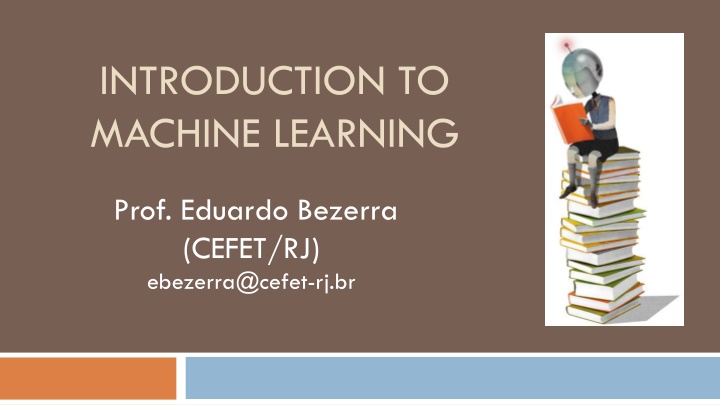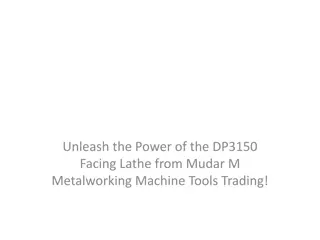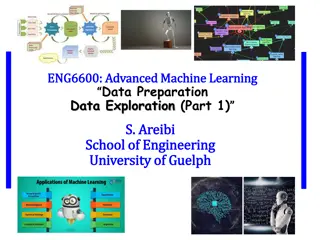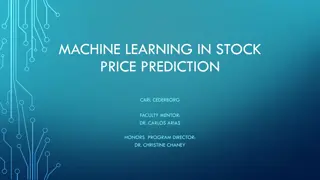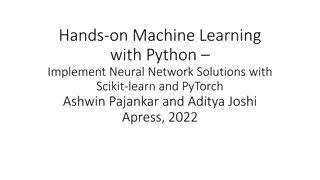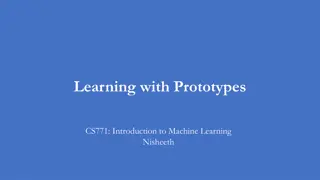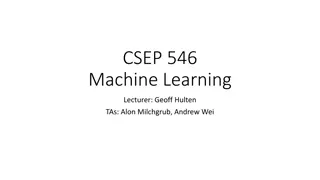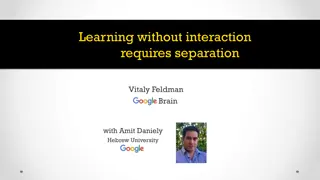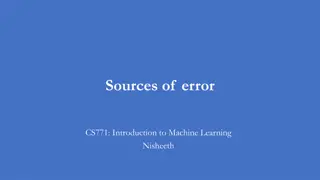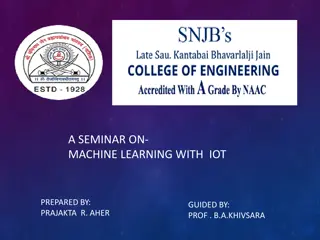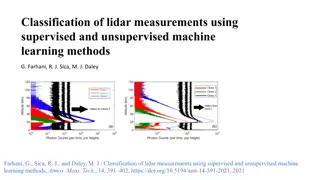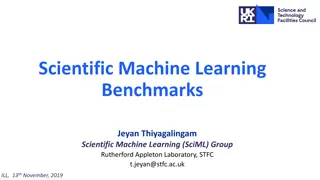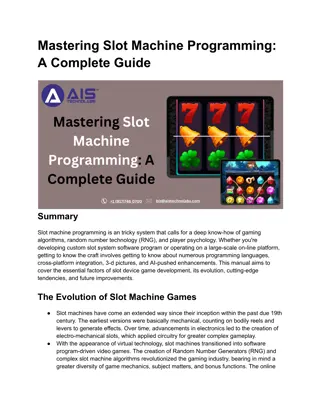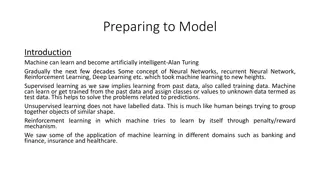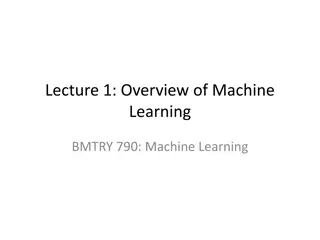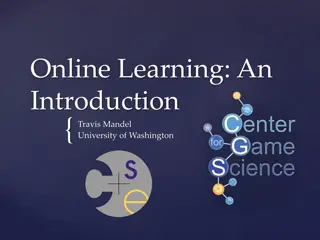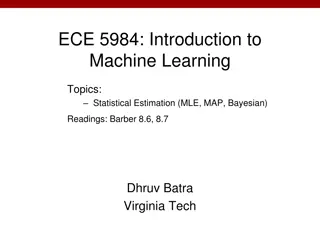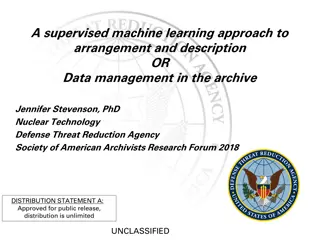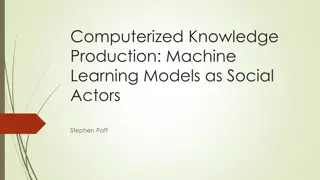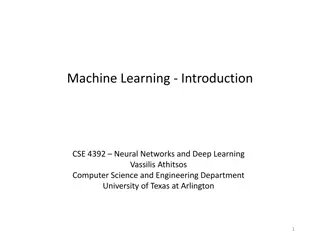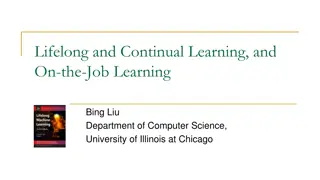Machine Learning Concepts: A Comprehensive Overview
Delve into the world of machine learning with insights on model regularization, generalization, goodness of fit, model complexity, bias-variance tradeoff, and more. Explore key concepts such as bias, variance, and model complexity to enhance your understanding of predictive ML models and their performance.
Download Presentation

Please find below an Image/Link to download the presentation.
The content on the website is provided AS IS for your information and personal use only. It may not be sold, licensed, or shared on other websites without obtaining consent from the author.If you encounter any issues during the download, it is possible that the publisher has removed the file from their server.
You are allowed to download the files provided on this website for personal or commercial use, subject to the condition that they are used lawfully. All files are the property of their respective owners.
The content on the website is provided AS IS for your information and personal use only. It may not be sold, licensed, or shared on other websites without obtaining consent from the author.
E N D
Presentation Transcript
INTRODUCTION TO MACHINE LEARNING Prof. Eduardo Bezerra (CEFET/RJ) ebezerra@cefet-rj.br
2 MODEL REGULARIZATION
Overview 3 Preliminary concepts Regularization Regulated linear regression Regulated logistic regression
Generalization 5 In predictive ML, the goal is to induce models that perform well in general, not just in the training set. We say that a model has a good generalization if it is able to make adequate predictions about data not used during training.
Goodness of fit 6 In ML, a hypothesis function is said to fit the training data. The hypothesis seeks to approximate the (unknown) target function. An important aspect to measure is the quality of this approximation.
Goodness of fit 7 A ML algorithm should exercise temperance in order to achieve goodness of fit. extremo meio-termo extremo
Model complexity 8 In AM, the complexity of a learning model relates to the amount of free parameters that it uses. A model too complex is formed by so many parameters that the model "memorizes" all training data. A model too simple is formed by an insufficient number of parameters that do not allow it to capture the underlying trends in the data.
Bias and variance of a ML model 9 Assume that we could retrain a model multiple times on different training datasets (samples). Variance measures the consistency (or variability) of the model prediction for a particular sample instance. Bias measures how far off the predictions are from the correct values.
bias-variance tradeoff 10 Increasing the bias will decrease the variance. Increasing the variance will decrease the bias.
Overfitting and underfitting 11 The inadequate complexity (of an inductive model) can lead to one of two phenomena, both unwanted: Overfitting Underfitting
Underfitting 12 Occurs when a ML model cannot capture the underlying trend of the data. An underfitted model shows low variance and high bias. Often a result of an excessively simple model. Rarely seen in practice.
Overfitting 13 Occurs when a ML model adapts to the training data, but does not generalize to new data. Usually caused by a complicated model that creates many unnecessary curves and unrelated angles to the population from which the training data came from. Often seen in practice!
Solutions to overfitting 15 Reduce the number of features Manually select which features to maintain. Use a dimensionality reduction algorithm. Regularization Maintain all the features, but reduce the magnitude of the parameters. Regularization works well when we have many useful features.
Regularization 17 Technique that penalizes complex explanations of the data, even if they are consistent with the training set. Rationale: such explanations do not generalize well. They may explain data points from the training set, but this may be only because of the specificities of the sample used for training.
Regularization basic ideia 18 General idea: produce parameters with small absolute values during optimization. Effects: simpler hypotheses (more smooth, less sinuous functions); resulting model is less susceptible to overfitting. Why does it work?!
Regularization - intuition (polynomial regression) 19 Suppose we want to force the model to the right to be more similar to a quadratic form...
Regularization - intuition (cont.) 20 To do this, we must reduce the influence of the following terms: e . This can be done by modifying the cost function and the minimization problem:
Regularization - intuition (cont.) 21 Effect: smoothing of the original model.
Regularization - general idea 22 We use the following general expression for the cost function in regularized linear regression: : regularization parameter : regularization term
Terminology 23 Tikhonov regularization (Math, inverse problems) Ridge regression (Statistics) Weight decay (ML) L1 regularization L2 regularization Ng, Andrew Y. (2004). Feature selection, L1 vs. L2 regularization, and rotational invariance. Proc. ICML.
Value for the regularization parameter 24 For a successful regularization, it is necessary to appropriately choose the value of What can happen if it is ... ... too large (e.g., )? ... very small (e.g., )? must be chosen by using model selection.
Cost function 26 is the regularization term.
Gradient descent 27 Without regularization: With regularization: is not influenced by regularization
Gradient descent (cont.) 28 Let us isolate in the expression for its update: The highlighted term is positive and close to zero: Thus, we can interpret the first factor as a depreciation applied to
Why is not regularized? 29 Overfitting usually occurs in models where the output is sensitive to small changes in the input data. i.e., model that interpolate exactly the target values tends to require a lot of curvature in the function being adjusted does not contribute to the curvature of the model. so there is no interest in regularizing it.
Cost function 31 Unregularized version: Regularized version:
